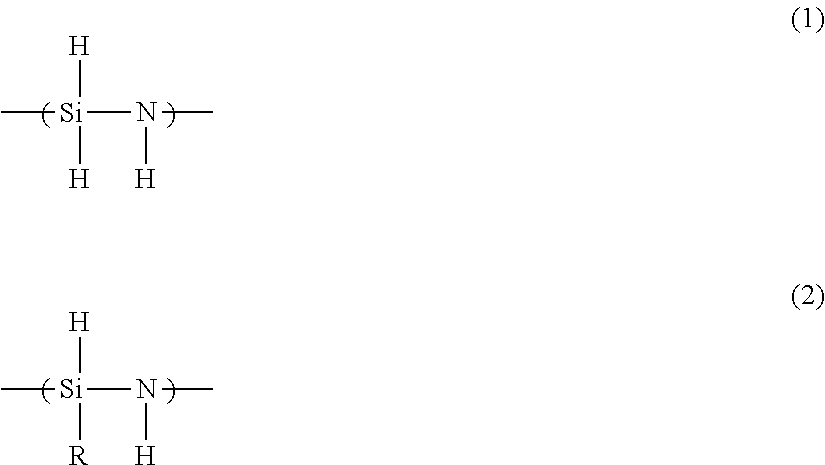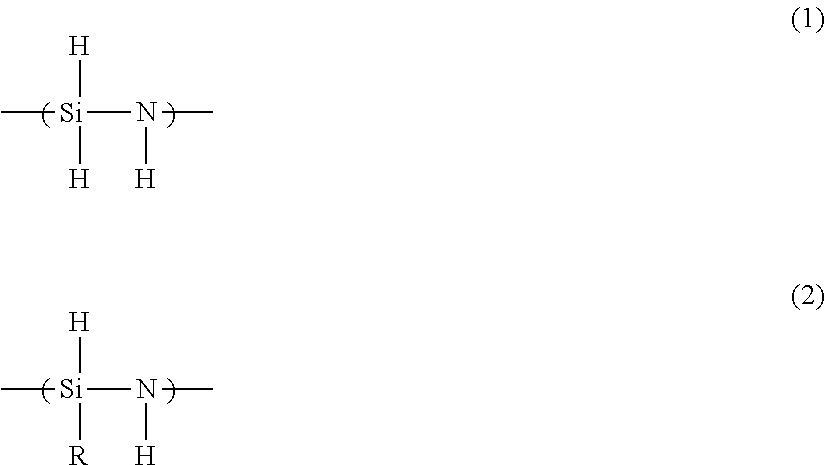Transparent coating film forming composition
- Summary
- Abstract
- Description
- Claims
- Application Information
AI Technical Summary
Benefits of technology
Problems solved by technology
Method used
Image
Examples
synthesis example 1
[0076]Into 300 ml of dehydrated pyridine at −10° C., 0.189 mol of dichlorosilane and 0.02 mol of methyldichlorosilane both having a purity of 99% or more were blown with stirring together with nitrogen gas. Then, 0.63 mol of ammonia having a purity of 99% or more was blown, and the produced salt was removed by pressure filtration to obtain a polysilazane solution. This polysilazane solution was heated to 150° C. and 150 ml of the pyridine was distilled out. Then, 300 ml of di-n-butyl ether (hereinafter abbreviated as “dibutyl ether”) was added, the pyridine was distilled out by azeotropic distillation, and dibutyl ether was added and adjusted such that with respect to 100 parts of the whole solution, polysilazane was 50 parts by mass as a mass ratio. Thus, a polysilazane-containing composition (a-1) was obtained. The weight average molecular weight of the resultant polysilazane (A-1) was 3,288, and the ratio of the number of Si—CH3 bonds to the total number of Si—H bonds and Si—CH3 ...
synthesis example 2
[0077]Into 300 ml of dehydrated pyridine at −10° C., 0.189 mol of dichlorosilane and 0.004 mol of methyldichlorosilane both having a purity of 99% or more were blown with stirring together with nitrogen gas. Then, 0.58 mol of ammonia having a purity of 99% or more was blown, and the produced salt was removed by pressure filtration to obtain a polysilazane solution. This polysilazane solution was heated to 150° C. and 150 ml of the pyridine was distilled out. Then, 300 ml of dibutyl ether was added, the pyridine was distilled out by azeotropic distillation, and dibutyl ether was added and adjusted such that with respect to 100 parts of the whole solution, polysilazane was 50 parts by mass as a mass ratio. Thus, a polysilazane-containing composition (a-2) was obtained. The weight average molecular weight of the resultant polysilazane (A-2) was 5,312, and the ratio of the number of Si—CH3 bonds to the total number of Si—H bonds and Si—CH3 bonds was 0.01.
synthesis example 3
[0078]Into 300 ml of dehydrated pyridine at −10° C., 0.189 mol of dichlorosilane having a purity of 99% or more was blown with stirring together with nitrogen gas. Then, 0.57 mol of ammonia having a purity of 99% or more was blown, and the produced salt was removed by pressure filtration to obtain a polysilazane solution. This polysilazane solution was heated to 150° C. and 150 ml of the pyridine was distilled out. Then, 300 ml of dibutyl ether was added, the pyridine was distilled out by azeotropic distillation, and dibutyl ether was added and adjusted such that with respect to 100 parts of the whole solution, polysilazane was 50 parts by mass as a mass ratio. Thus, a polysilazane-containing composition (a-3) was obtained. The weight average molecular weight of the resultant polysilazane (A-3) was 6,725.
PUM
| Property | Measurement | Unit |
|---|---|---|
| Temperature | aaaaa | aaaaa |
| Pressure | aaaaa | aaaaa |
| Transparency | aaaaa | aaaaa |
Abstract
Description
Claims
Application Information
 Login to View More
Login to View More - R&D
- Intellectual Property
- Life Sciences
- Materials
- Tech Scout
- Unparalleled Data Quality
- Higher Quality Content
- 60% Fewer Hallucinations
Browse by: Latest US Patents, China's latest patents, Technical Efficacy Thesaurus, Application Domain, Technology Topic, Popular Technical Reports.
© 2025 PatSnap. All rights reserved.Legal|Privacy policy|Modern Slavery Act Transparency Statement|Sitemap|About US| Contact US: help@patsnap.com



